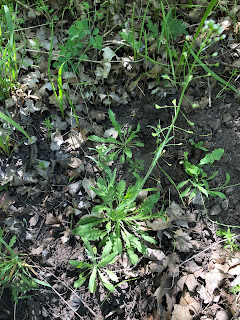 |
| Capsella bursa-pastoris |
 |
| basal leaves |
Capsella bursa-pastoris, commonly known as Shepherd's Purse, is a common weedy plant found in both the country and in cities, where it seems especially well adapted to growing in sidewalk cracks. It is a member of the mustard family, and like most of these, it has small, four-petaled flowers (white in this case), and the seed capsules grow on short stalks which branch off from the main stem one at a time in all directions. The way to identify this particular species is from the the triangular-shaped seed pods. Zoom in on the picture to see them better.
I like eating the tender flower clusters at the top of the stalk, and also the green seed capsules which grow along the stalk. They have a nice mild flavor. Unlike many types of mustard, this plant is very mild, without the pungency or spicy-hot flavor common in a lot of mustards. I can keep eating these flowers and seed capsules all day, even raw, without getting a hot or burny sensation in my mouth. One definitely cannot do that with mustards such as watercress, whitetop, or tumble-mustard.
It has very few leaves on the stem and these are small. The basal leaves are a little larger, but I find them to be a bit tough for eating. And I did eat quite a few of them while testing them for spiciness. Even the small basal leaves before the seed stalk forms are tough. On the other hand, Sam Thayer reports in his book "Incredible Wild Edibles" that Shepherd's Purse growing "in moist soil laden with organic matter" can be large and lush, but that is not the kind of soil we have in the Rocky Mountains or under sidewalk cracks.
Many edible plant references state that "the seedpods can be used as a peppery seasoning for soups and stews." This is absolutely not true, and anyone who states this reveals that they have no personal experience with the plant, and are simply repeating myths that they have read elsewhere. The whole point of pepper is to add a spicy-hot flavor to your food. But Shepherd's Purse is actually one of the mildest mustards I have eaten. As a second witness to this, I will quote Sam Thayer again: "shepherd's purse is mild enough to form the base of a salad". He says nothing about peppery seeds, but he busts another myth about the roots being similar to ginger.
So, I highly recommend eating the flowering tops, and the seed pods. You can even add them to your stew; just don't expect them to add any appreciable flavor.